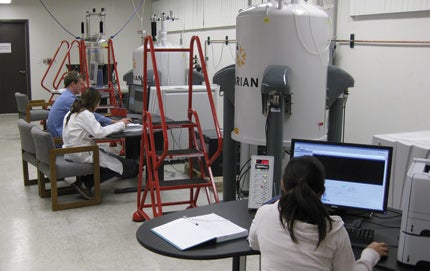Chemistry Off the Charts
Great scientists make great science happen. But clearly they need cutting-edge facilities for ground-breaking scientific research.
And that’s what is happening in USC College’s Department of Chemistry.
The vision of Executive Vice President and Provost C.L. Max Nikias as described in the USC Biomedical Nanoscience Initiative has become a reality. It is called the Biomolecular and Small Molecule Nuclear Magnetic Resonance (NMR) Facility — a place where molecule structures are studied on a scale of less than a billionth of a meter.
External funding from the National Science Foundation and the National Institutes of Health (NIH) combined with support from the College and the Provost’s Office resulted in a new suite of NMR spectrometers: 600, 500 and two 400 megahertz models.
“The department has outstanding research faculty,” said Charles McKenna, chair of chemistry, “But they require advanced instrumentation to stay competitive. These new NMR instruments provide essential, state-of-the-art capabilities that are critical for our research performance. They will also assist us as we continue to recruit the best new faculty in years to come.”

USC College chemists Dr. Brian Conley, Xinping Wu, and Alejandra Aviles at work in a room of the newly equipped NMR facility (from right to left: the new 500 and 400 MHz NMR spectrometers, and an older 400 MHz instrument in the background).
McKenna noted that the 600 MHz model will primarily be used to study biological molecules such as proteins, while the other three are for research on small molecules.
“With the new NMR capabilities that we have acquired during the past year, our scientists are able to better see the structure of molecules containing hydrogen, carbon, phosphorus, fluorine and other atoms using highly sophisticated technology,” McKenna said.
In fact Travis Williams, assistant professor of chemistry, said: “USC is now probably one of the best campuses in America to be an NMR spectroscopist.”
Williams also points out that having this equipment in the College has a two-fold impact. NMR time is inexpensive at USC as compared to most research universities. Therefore, students are encouraged to think outside of the box and test their innovative ideas.
With better scientific tools, Williams’ group has published two high-impact papers. One was recently published in American Chemical Society, a top journal for the chemical sciences.
Another ongoing chemistry acquisition, which will have a profound impact in producing extraordinary molecular science at USC, is a $1 million pulse EPR-ENDOR spectrometer to measure electron spin resonance. By contrast, NMR spectrometers measure nuclear spin resonance.
Funded by an NIH stimulus grant to the chemistry department with support from the College and Provost’s Office, this machine will permit chemists and biologists in the College and the Keck School of Medicine of USC, and at the California Institute of Technology to investigate problems ranging from the molecular basis of virus infections and cardiovascular events to the function of DNA repair in cancer and the mechanism of N2 fixation.
Professors of chemistry Mark Thompson, Richard Roberts, Kyung Jung and Peter Qin took the lead in joining McKenna and other faculty participants to contribute the time and expertise required for the rigorous proposal writing process, which resulted in the four major government grants awarded to fund the new NMR and EPR instruments.
Read more articles from USC College Magazine’s Spring/Summer 2010 issue.